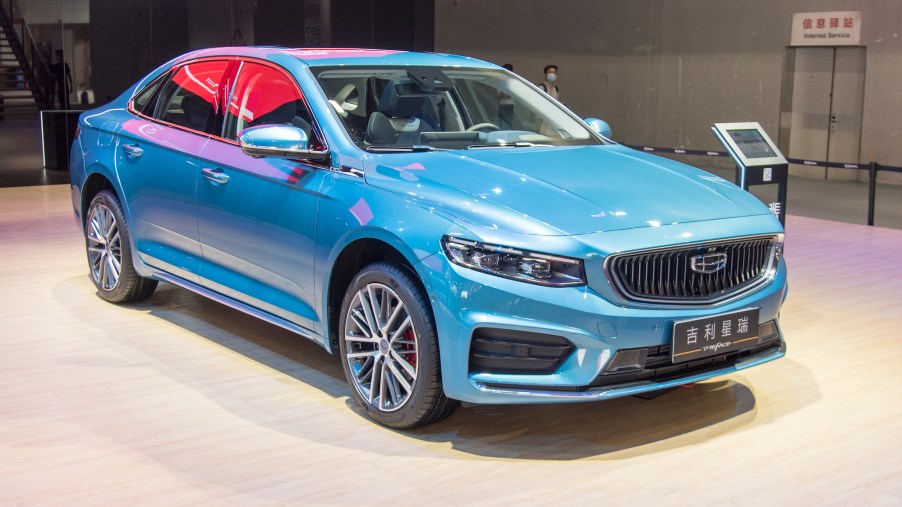
Most People Have Never Heard of 1 of the Biggest Automakers in the World
The folks at Donut Media recently posted a YouTube video about one of the world’s biggest automakers. But you may have never even heard of it despite years of car buying. A leading automaker based in Hangzhou, Geely Auto Group is China’s first privately owned car manufacturer.
Where did Geely come from? Donut Media gave us all the details on this fascinating story.
A little background
It all began in the 1960s with young entrepreneur Li Shufu. The Donut Media team describes him as someone with a great sense of humor. He took pictures of tourists, recycled precious metals, and eventually started a refrigerator business. When he grew bored with refrigerators, he donated the business to the local government in the ’80s.
Li sought something a little less competitive, so he chose the automobile market. Though it’s very competitive in the United States and Europe, the same can’t be said of China. The industry was just getting started there in the ’90s, and the country had no privately owned car companies.
Claiming that cars were “just two couches on four wheels. How hard can it be?” Li dove into the automobile industry. It was a rough start. Starting with the purchase of a failing motorcycle business, Li began producing bikes in the first privately owned motorcycle maker in China. He named the company Geely, which means “lucky.”
The name might’ve been an omen in the long run. Li’s next goal was to produce a luxury sedan, but that effort failed spectacularly. Even though he’d purchased a Mercedes-Benz E280 and dissected it to see how it was made and what it offered, Geely’s first vehicle was the ill-fated Number One. Its appearance was as lacking as its performance, and it proved to be quite unreliable.
From disappointment to success
After the failed luxury car attempt, Li set his sights instead on producing affordable cars for everyday people. Wanting to produce a better hatchback than the fairly popular Daihatsu Charade, he bought a few competitor hatches and dissected them as he had done the Mercedes.
By late summer 1998, the first Geely Haoqing rolled off the line. Just like the Charade, it had a 1.8-liter four-cylinder engine from Toyota that got 83 hp. Geely was improving at making cars, but no one bought them.
Hard plastic covered the cabin, the paint wasn’t very good, and gaps between panels allowed water to seep into the car. A single person came to the premiere party. Incensed, Li took an actual steamroller to all 100 Haoqing cars he had produced.
Geely’s second take on the Haoqing debuted in 1999. It was much better, and it started selling. The automaker became profitable. It did well enough to buy a second factory and produce a new model, the Meiri.
After joining the World Trade Organization in 2001, Geely became a fully privately owned company. It began the development of the first self-developed sports car in Chinese automotive history, Donut Media reported. The Meirenbao had a 1.5-liter Toyota engine paired with a manual five-speed transmission. It was a good-looking car with potential.
However, Toyota chose that time to double the retail price of the engines it supplied to Geely, forcing the company to develop its own engine. Similar to Toyota’s Effie, Geely’s econoboxes sold well indeed.
In the decade that followed, Geely began popping up everywhere, quietly gaining dominion as an auto brand.
The future’s so bright
The company made the news when Ford announced the sale of Volvo to Geely in 1999 for $1.5 billion. It’s amazing considering that 10 years earlier, Geely couldn’t sell a single car. By the 2000s, the automaker owned one of the most visible car brands on the planet.
Li allowed Volvo to do what it did with minimal supervision. Once they finalized the deal in 2010, Geely began using Volvo technology for its own brand, with fantastic results. Geely’s engines improved, and Li was finally able to design that luxury sedan he wanted.
The timing was fortuitous — China was a wealthier nation and wanted luxury cars. In 2015, the Geely Borui debuted with a nice lineup of engines, including a 1.8-liter turbocharged four-cylinder and a 3.5-liter V6 harnessing up to 261 hp. The car had different trim levels too.
From that point, the company launched Lynk & Co in 2016 and began selling Chinese-Swedish vehicles that fall somewhere on the spectrum between Geely and Volvo. In May 2019, Geely launched a production facility solely to produce Compact Modular Architecture (CMA)-based vehicles for the brand’s foray into its advanced-products era.
Since then, Geely has been producing new vehicles, offering new services, and staying on top of innovation. If you haven’t heard much about the company until now, you soon will.


